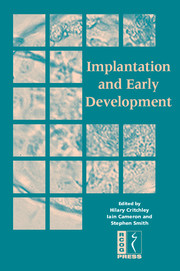Book contents
- Frontmatter
- Contents
- DECLARATION OF INTEREST
- Participants
- Preface
- SECTION 1 PREPARATION FOR IMPLANTATION – THE UTERINE ENVIRONMENT
- SECTION 2 THE EMBRYO
- 9 What makes a good egg?
- 10 What makes ‘good sperm’?
- 11 Morphogenesis of the early mammalian embryo: cell lineage heterogeneity and developmental potential
- 12 Epigenetics in development and cloning by nuclear transfer: alternative approaches to nuclear reprogramming
- 13 Risks associated with assisted reproduction: insights from animal studies
- 14 Pre-implantation genetic testing
- SECTION 3 LESSONS FROM ANIMAL MODELS (TRANSGENICS) AND NOVEL TECHNOLOGIES
- SECTION 4 CLINICAL SEQUELAE
- SECTION 5 CONSENSUS VIEWS
- Index
14 - Pre-implantation genetic testing
from SECTION 2 - THE EMBRYO
Published online by Cambridge University Press: 05 June 2014
- Frontmatter
- Contents
- DECLARATION OF INTEREST
- Participants
- Preface
- SECTION 1 PREPARATION FOR IMPLANTATION – THE UTERINE ENVIRONMENT
- SECTION 2 THE EMBRYO
- 9 What makes a good egg?
- 10 What makes ‘good sperm’?
- 11 Morphogenesis of the early mammalian embryo: cell lineage heterogeneity and developmental potential
- 12 Epigenetics in development and cloning by nuclear transfer: alternative approaches to nuclear reprogramming
- 13 Risks associated with assisted reproduction: insights from animal studies
- 14 Pre-implantation genetic testing
- SECTION 3 LESSONS FROM ANIMAL MODELS (TRANSGENICS) AND NOVEL TECHNOLOGIES
- SECTION 4 CLINICAL SEQUELAE
- SECTION 5 CONSENSUS VIEWS
- Index
Summary
Introduction
Since its first clinical use, pre-implantation genetic testing (PGT) has become increasingly available as a method of detecting genetic disorders before pregnancy is established. Based on a difference of purpose, PGT can be classified as either pre-implantation genetic diagnosis (PGD) or pre-implantation genetic screening (PGS). PGD was established in the early 1990s as an alternative to prenatal diagnosis (PND) and termination of pregnancy. PGD describes the testing of oocytes or embryos from patients who have a significant risk of conceiving a pregnancy affected by a known recurrent genetic disorder, in order to preselect for transfer only those embryos found not to carry the disorder. PGS, on the other hand, aims to improve the outcome of assisted reproductive technology (ART) treatment for the subfertile by testing for a number of the more frequent chromosome aneuploidies in an attempt to improve implantation and reduce the incidence of miscarriage. It is estimated that worldwide, more than 1000 children have been born following PGT. The clinical application of PGT is expanding into new areas, creating novel ethical and practical dilemmas.
In order for a pre-implantation genetic test to be performed, a representative sample of the embryo is required. A single cell can be removed from a late cleavage stage embryo (8—16 cells), or a few cells may be taken from the trophectoderm of a blastocyst, or one or both of the polar bodies can be removed from the unfertilised egg or early zygote.
Keywords
- Type
- Chapter
- Information
- Implantation and Early Development , pp. 169 - 182Publisher: Cambridge University PressPrint publication year: 2005

